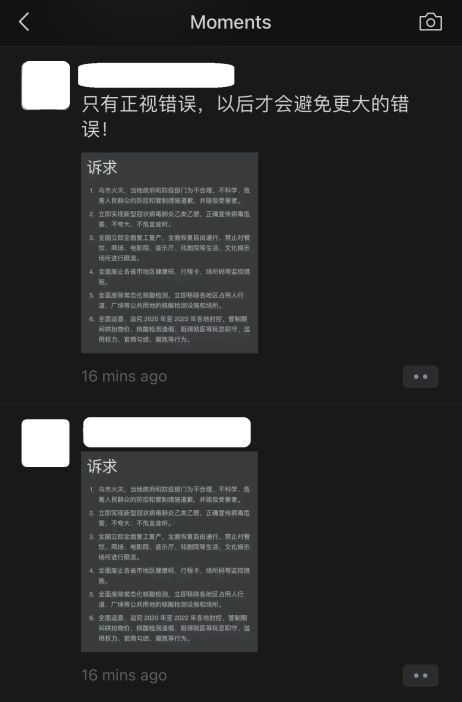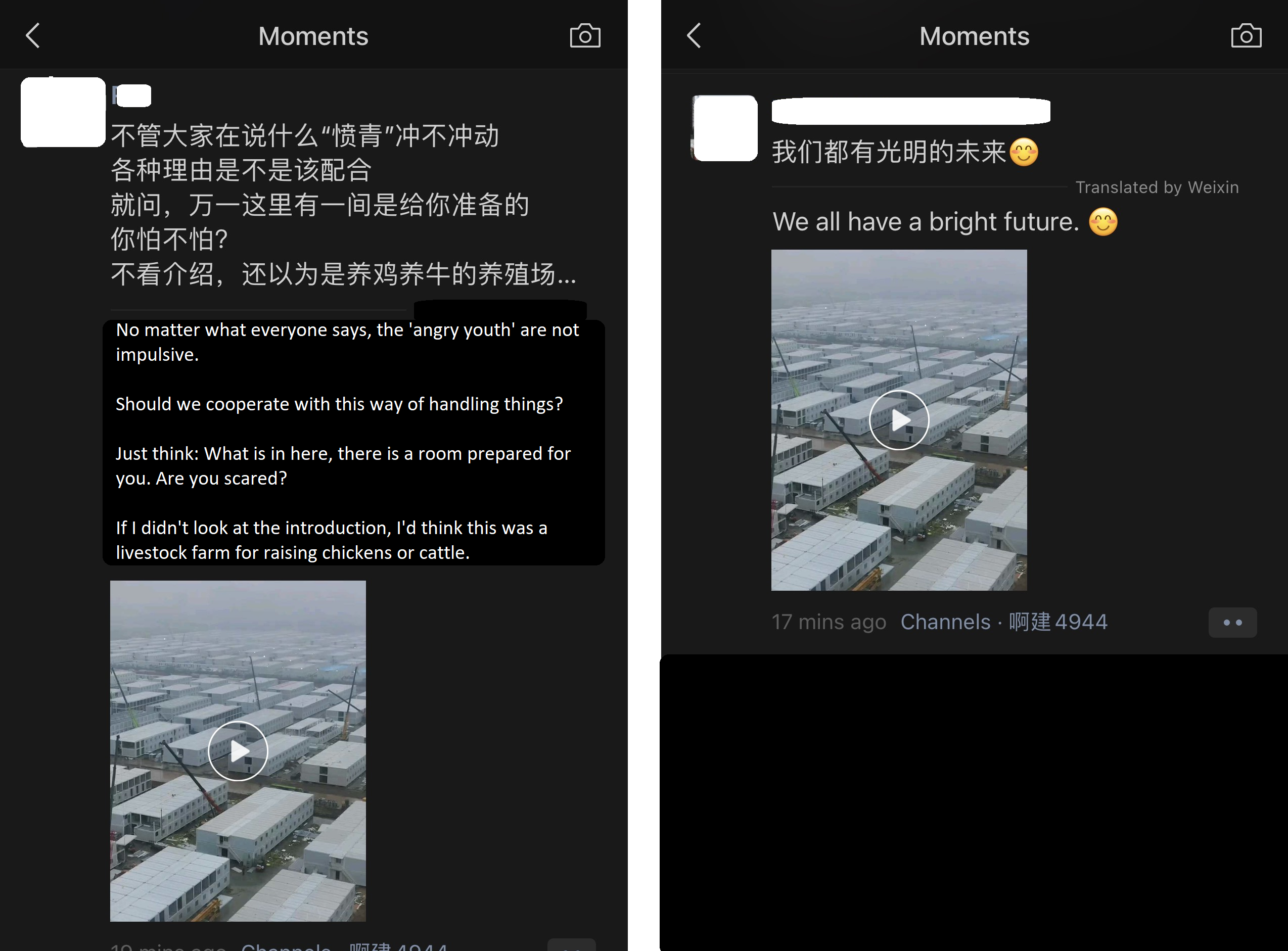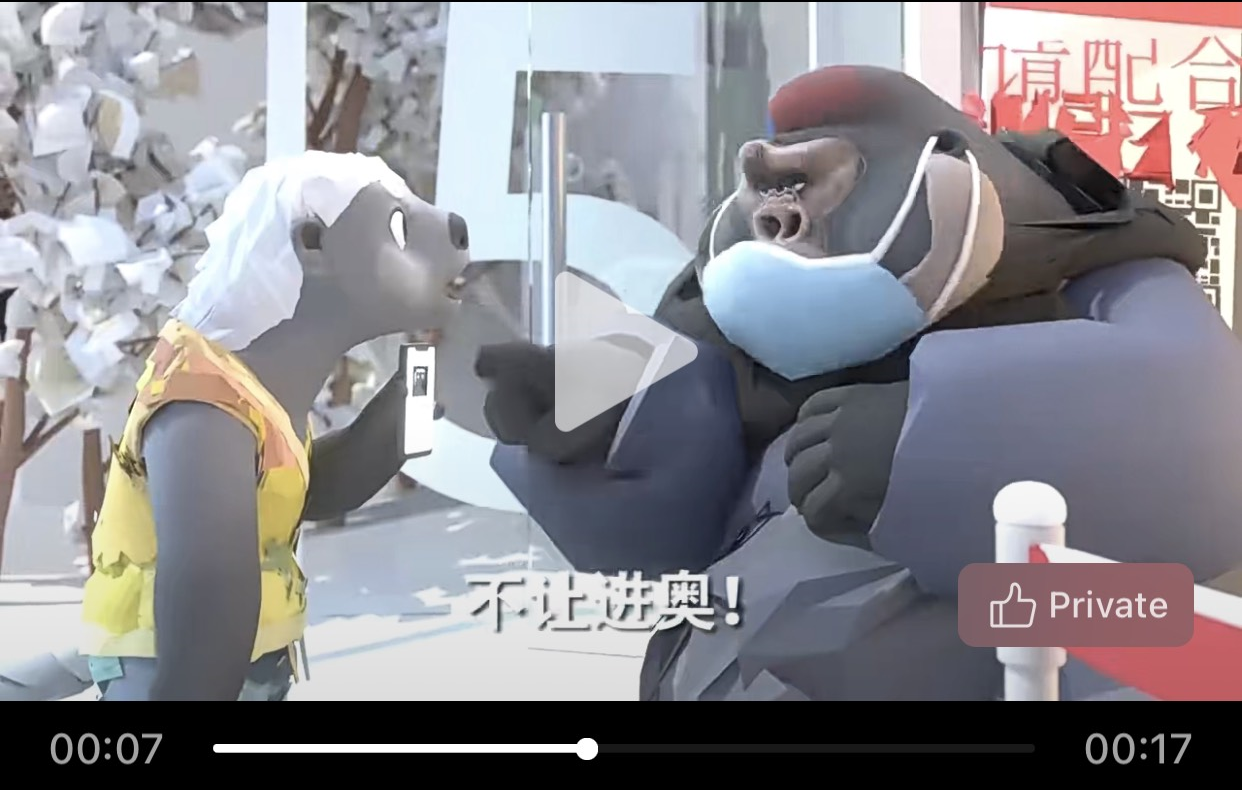Street protests against the strict zero-COVID policies in China shocked onlookers the world over last week, and even led some to call it the country’s biggest uprising since 1989’s Tiananmen demonstrations. But analysts focused on China’s censorship apparatus were equally fascinated by the dissent online. After all, Chinese authorities and internet companies have spent years deploying swarms of censorship staff to monitor and root out social media content that clashes too brazenly with the government’s rigid state media narratives, while AI and machine learning have given that dissent-stifling apparatus a new stratum of sophistication.

WeChat users share a list of six demands related to the zero COVID protests.
So when many users of WeChat – China’s “everything-app” for messaging, online payments, social media, and more – saw a number of their contacts post pointed critiques of the country’s recently ramped up pandemic lockdowns, nucleic acid test mandates, sordid quarantine facilities, and more, they were left to wonder how such content got through.
One such post from late November contained a list of six demands that included – but went well beyond – replacing “unreasonable and illegal zero-case policies” with measures backed by “professional medical research.” It also called for an apology to victims of a recent fire in a predominantly Uyghur neighborhood in Urumqi, Xinjiang, who are said to have died because an unwavering lockdown prevented both them from escaping or firefighters from coming close enough to rescue them. That has especially turned heads because of the sensitivity in China to critiques of its treatment of Uyghurs, which has been called a genocide by some some, including a spokesperson for U.S. President Joe Biden’s then presidential campaign in 2020.
“When I first saw netizens pushing back against these [zero-COVID] policies, I was surprised at how direct online commentators were in their criticisms,” Manfred Elfstrom, a political science assistant professor at the University of British Columbia, told The Diplomat. “I was also impressed with the compassion and solidarity shown by many toward people in Urumqi.”
Other users shared videos last week of Chinese COVID-19 quarantine facilities, griping about how they are notoriously cramped, poorly heated, and garbage strewn. One netizen deemed them fit to only house cattle.

WeChat users share (and critique) a video of a centralized quarantine facility.
Even more surprising than the posts themselves, those posts remained on the WeChat Moments page for days, from late November into early December – some staying up even now.
On the following weekend, a wave of new posts criticized the country’s strictly mandated yet erratically implemented COVID-19 testing regime. Among the most popular: clips of a cartoon character with redubbed dialogue about being unable to enter buildings because he could not access COVID-19 test kiosks, which had shut down or were overwhelmed with long queues amidst Beijing’s recently frigid weather.

A screenshot of a cartoon, widely shared on WeChat. The caption says “No entry!”
One interviewee living in Yunnan province, who asked to be quoted under the pseudonym Dou Lao for fear of retribution by the authorities, was among the netizens who posted the list of six demands. When asked by The Diplomat about what prompted her to defy China’s measures against dissent, she said “the zero-COVID policy is too stupid.” Dou called the official measures an overreaction, given Omicron’s relatively mild symptoms.
From there, she pointed to both the Urumqi fire and also the death of 27 people in Guizhou in September when a bus crashed while rushing to a quarantine facility. That incident led to some heated comments this fall, mostly on China’s microblogging platform Weibo, though those outcries pale in comparison to the current groundswell on much of Chinese social media like WeChat Moments and Douyin (the Chinese version of short video sharing platform TikTok).
Aside from the deaths in Guiyang and Urumqi, Dou also says she is angered by how lengthy lockdowns and other restrictions have prompted “more and more people to choose suicide, because they cannot earn money and maintain their lives. So this policy is totally unreasonable and wrong in my mind.”
All that is apparent not only to those like Dou on the ground, but also to China watchers abroad. Anthony J. Saich, director of the Rajawali Foundation Institute for Asia at Harvard Kennedy School, says he was surprised that the social media posts like Dou’s “tapped into a widespread sense of frustration across many cities with the unpredictability and randomness of the approach to COVID. With the catalyst of the fire in Xinjiang setting off sympathetic demonstrations in other cities, social media allowed the protests to adopt similar themes and concerns. The contents are not that surprising, but the fact that they are posted is.”
Bin Lee, a Chinese netizen based in Shanghai, said the social media outpouring was not only driven by frustration but also “helplessness. I think these are the emotions that most people shared last weekend. It’s something that has been accumulating for a long time.”
While some users have yet to suffer consequences from their negative posts, despite the government’s ability to closely monitor and track activity on domestic social media platforms, others like Bin had their accounts temporarily suspended last week. This confused him, because “I am pretty sure I haven’t posted anything that touches the red line on my Moments nor in any group chats. Most of my conversations are within private messages, and even for that, I haven’t said anything super sensitive. The unclear standard of censorship makes people feel even more suffocated.”
Jason Ng watched the flood of negative social media content with fascination. Ng is the author of “Blocked on Weibo,” a book about Chinese social media, and a research consultant who developed censorship monitoring tools for the China Digital Times. He called netizens’ reactions and officials’ sporadic suspension of some accounts, even as many critical posts remain online, a “breaking point of the information controls that have been put in place… because it is not a niche targeted protest” like those that occasionally spring up against local corruption, which the state sometimes permits. Instead, Ng said, the current situation is a “widespread protest among many different groups. And now you’re seeing opportunities for people to use the internet and mobilize.”
That point was seconded by Elfstrom, the UBC professor. “It’s hard, of course, to know how much is being blocked. We just see what gets through the censors,” he admitted. “Still, it does seem like the system has been overwhelmed.”
Netizens’ savvy should not be overlooked, said Saich, the Harvard Kennedy School professor. “It shows just how hard it is to maintain the level of censorship, when a sudden event occurs,” he said. “The young people are smart and know their way around social media to post materials.”
“However,” he added, “the longer an event lasts, the more the censorship apparatus can regain control and post its own supportive comments.”
Ng’s prior research with The Citizen Lab delved deep into prior iterations of China’s censorship apparatus. He describes “rudimentary keyword filters catching things online, or outright blocking things to begin with. Then you’d have a fleet of white collar arbitrators judging it, refining the keyword filters.” They would deem “‘x keyword cannot be discussed online at this time’” because of recent news events that did not align with part narratives. At other times those censors would realize a sensitive trend was emerging and hurry to stamp it out, Ng said. But this model wasn’t always “fast enough to catch things, and is tough to scale,” and therefore AI and machine learning have more recently made the process “more nimble in real time.”
And while Ng agreed with Saich that netizen’s cleverness and the sheer volume of ongoing responses might have circumvented China’s cutting edge, AI-powered internet censorship, officials and internet companies could also be “letting the steam vent before the pressure inside gets too high.”
He recalled monitoring more niche pushback in the past, where the state permitted complaints about regional officials’ malfeasance, because it helped them root out corruption while also letting citizens feel like their voices were heard. Then worries about those complainers becoming too emboldened caused higher-ups to tamp down once again.
“All of the sudden the ground can shift under your feet, and posting about what you thought would have no consequences can cause you to be detained,” Ng said. “But there’s a huge undercurrent of outwardly critical posts, or vaguely critical discussion of sensitive topics, online in China. And there are [often] no consequences because there is such a sea of information.”
That vastness of China’s internet landscape leaves Elfstrom wondering about the outcome for naysaying netizens. “It is not difficult to track down who has posted what in China. So, people are taking some risk in posting this kind of content. The question, I suppose, is how wide of a net authorities will end up casting in punishing people. My guess would be that they will not try to go after everyone. And street protesters will obviously come in for more pressure than online commentators.”
Saich is less optimistic: “The risks are high and probably not understood by those taking part in their first demonstrations and protests. The authorities will comb through records to locate those people who they see as instigators or promoters of the protests.”
However, Bin argued that protestors have a better grasp of the situation’s gravity than some onlookers may realize. Aside from being well aware of the dangers of dissent in China, either on or offline, he said outspoken Chinese are also self assured about their motivations, despite any state media narratives to the contrary.
“Although in the beginning people stood out and spoke against violence and unreasonable quarantine enforcement, which inspired people like me, soon there were other people claiming that all the protests seem to be irrational and related to the involvement of ‘foreign affairs.’ I find it ridiculous and condescending, and think many of those who say that are privileged groups whose lives have not been influenced by zero-COVID at all,” said Bin.
Answering to accusations about the protests being orchestrated by foreign forces, people on the streets of Beijing roared: We can’t use foreign internet, we are not allowed to travel outside of China, how would outside forces even communicate with us? (WeChat video from friend.) pic.twitter.com/aYsZGZS8Cq
— Jojje Olsson (@jojjeols) November 29, 2022
The ongoing opposition is indeed an undeniable indication of just how savvy and assertive young Chinese citizens are becoming, according to Elfstrom, even as the authorities attempt to not only silence and lock them down, but also disparage their intentions. As he put it, “Even if the protests are brought under control, it feels like state-society relations have been changed in a way that will be difficult for authorities to undo.”
But Dou is less certain about the lasting implications. “At the beginning I felt hope and expected something would be changed” she said, after seeing social media posts were not immediately scrubbed by the censors. “But now… I feel deep hopelessness every day. I try to wake up more people, but most of the time it is in vain. Instead, they thought I was crazy, and a sense of powerlessness emerged spontaneously… Most Chinese are still numb. As long as a disaster does not happen to them, they will feel that they will never have anything to do with this disaster.”
Manya Koetse has a more nuanced view. The founder and editor in chief of What’s On Weibo, an independent blog and news website covering trending Chinese social media topics, Koetse believes protestors made a lasting impact. She outlined her reasoning in a What’s On Weibo newsletter that rounded up shifting local policies, state media articles with a more relaxed tone about the virus, and social media users “celebrating a farewell to ‘zero COVID’ as they know it.”
“So much has happened already. Even though policies are still changing, and local authorities need to find their place and way forward in this new zero-COVID landscape, that sense of despair, I don’t really see that,” Koetse said when asked about Dou’s comments.
Koetse’s reporting has also detailed how some Chinese citizens have spoken out, only to realize their families harbor opposite views, prompting them to take to Weibo and recount how such encounters were as daunting as “coming out of the closet.”
Indeed, Koetse’s coverage has helped her realize many citizens do not agree with dissenters online or in the streets, and are instead still afraid of how COVID-19 might impact the nation’s undervaccinated elderly.
Regarding those who have been vocal online or in public, Koetse said, “I don’t think the majority of people agree with some of the protest slogans that have been put out there, especially in Shanghai when some said ‘down with the party and Xi Jinping.’ That was never the goal for many people. It was people mourning those in Urumqi, then going against excessive lockdowns and unnecessary measures. After that I think it’s where the majority stops agreeing.”
However, she added, “I think what everyone feels the same about is, yes, they are sick of excessive COVID measures that are being pushed locally, and that have led to lost wages and so on. I really think those protesters have been heard.”

































